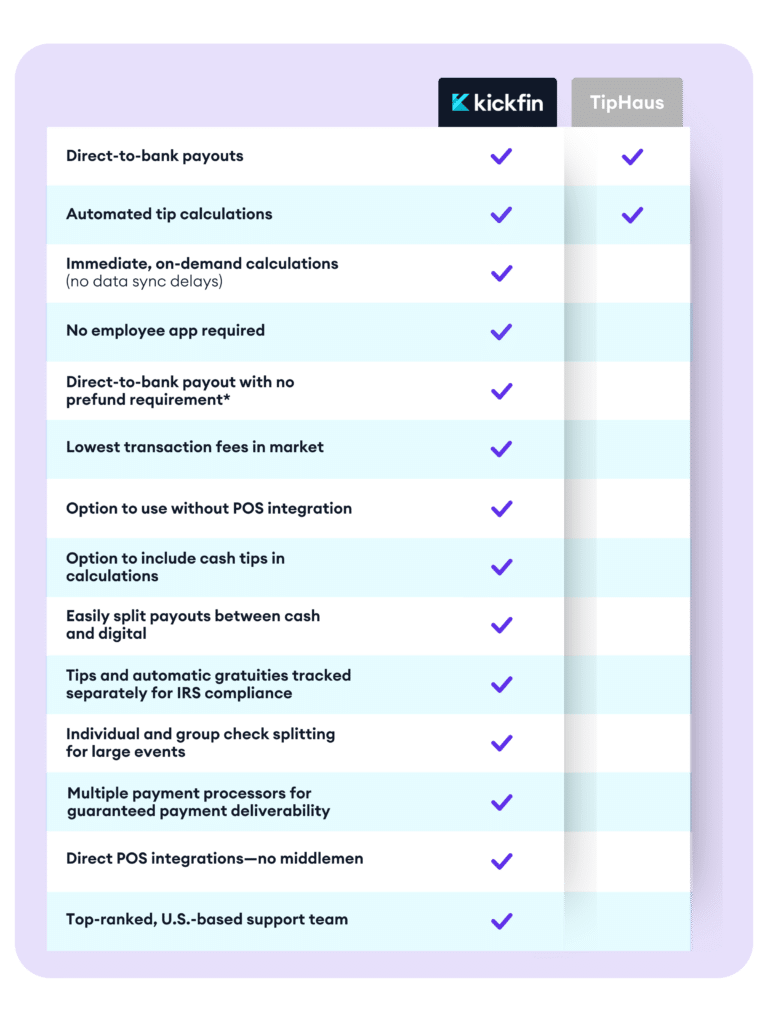Service charges, a customary practice in numerous industries, have become far more common in the cost-intensive, low-margin restaurant business in recent years.
A service charge is a fee added to a customer’s bill to cover various aspects of service on top of the cost of goods (i.e., food and beverage). Service charges can serve multiple purposes depending on the restaurant’s policies, from supplementing staff wages to offsetting operational costs.
While service charges are legal, they’re often misunderstood — and somewhat controversial. Diners don’t love being surprised at the end of a meal with an unexpected fee — especially if it’s not clear what the fee is actually for or where it’s going. Many assume it’s a tip (it’s not!), which can negatively impact employees’ take-home pay.
While service charges can be useful for operators who are fighting an uphill battle against inflation or staffing issues, it’s critical to understand exactly what a service charge is (and isn’t), how to implement one, and what to consider when it comes to compliance and reporting.
What is a service charge in the restaurant industry?
In the restaurant industry, a service charge is a mandatory fee that gets added to a customer’s bill. This fee is typically a fixed percentage of the total bill amount and often ranges from 10% to 20%.
It’s important to note that a service charge is not a tip or a gratuity, which are voluntary amounts left by customers in appreciation for service provided. Instead, a service charge is a mandatory charge, often used to cover the costs associated with providing the service, such as staff wages, maintenance, or administrative costs. These charges are common practice in many restaurants, particularly in fine dining or restaurants with large numbers of staff.
As Beth Schroeder of Raines Feldman LLP explained in her recent Hot Tips & Takes interview, the proceeds of service charges are the property of the restaurant to do with as management sees fit.
Service charges for restaurant owners can help to:
- Compensate for staff expenses: One of the primary reasons many restaurants implement a service charge is to help cover staff salaries and benefits. While tips can often supplement these costs, they are not always reliable and can fluctuate greatly. Service charges provide a more consistent and reliable revenue stream, ensuring that restaurant staff are compensated fairly for their work.
- Maintain high service standards: Service charges can also be seen as a reflection of the superior service offered by the establishment, as they’re often found in high-end restaurants where exceptional service is part of the dining experience. Funds generated through service charges can be used to invest in training and development programs for the staff, helping to maintain high service standards.
- Balance food costs and pricing: Implementing a service charge can help balance the cost of high-quality ingredients with competitive pricing for the customers. Restaurants operating in a higher price range often use premium ingredients, and a service charge helps offset these costs without needing to increase menu prices significantly.
- Share tips equitably among staff: In many establishments, tips are shared among the service staff only. By implementing a service charge, restaurants can ensure a more equitable distribution of tips among all staff members.
- Offset the cost of bottle service: For restaurants offering bottle service, the associated costs can be substantial. This service often involves premium liquors and additional staff to cater to the table. By applying a service charge, restaurants can help offset these costs.
- Facilitate large group payments: Service charges are particularly advantageous when catering to large groups or events, such as banquets or parties. A preset service charge can ensure that the staff is equitably compensated for their time and effort and that costs associated with special decorations or other incidentals are covered.
- Address split meal charges: When large parties dine together and split bills, it creates additional work for service staff. A fixed service charge helps compensate for this increased workload.
- Accommodate delivery fees: One last case where service charges are common is in covering delivery fees. As food delivery has gotten more popular, restaurants have had to bear the cost of partnering with food delivery platforms. These platforms charge a significant percentage of the order total as their fee. By incorporating a service charge, restaurants can manage these expenses without having to compromise on the price or quality of their food.
What’s the difference between a service charge and a tip or gratuity?
While this can be confusing to diners, service charges and tips/gratuities are not the same. The key differences between a service charge and a gratuity:
- Service charges are compulsory. Service charges are mandatory and non-negotiable. Tips, on the other hand, are not required. Yes, they’re often expected — and many hospitality employees rely on them to increase take-home pay — but ultimately, tips are discretionary and generally based on the quality of the meal and service.
- Service charges are a set percentage of the bill. A service charge is a fixed percentage of the total cost of a meal as determined by the employer; it generally ranges from 10-20% of the bill. With tips or gratuities, while 15-20% is a customary percentage of the bill, the amount is completely up to the customer.
- Service charges belong to the employer. Service charges can be used to increase staff wages, but ultimately, it’s the employer’s call as to where those funds go; operators might choose to use a service charge to offset other costs of doing business. Tips, on the other hand, belong solely to employees. Employers can implement tip pools or tip shares to distribute tips more equitably among employees, but it’s illegal for them to keep any portion of tips from any employee.
- Service charges are categorized differently by the IRS. When a service charge is used to increase employee compensation, it’s still not considered a tip. It must be reported as a “non-tip” wage.
Tipping on top of service charges
It’s important to understand that tipping is also still typically expected on top of the service fee.
Again, though a service charge can contribute to the staff’s wages, that’s not always the case. Employers might use service charges for other costs of doing business. When this happens, “service charge” is a bit of a misnomer; that is, customers may (reasonably!) assume that the fee is going to the person or people who provided the service. As a result, customers might be less inclined to leave a tip.
That’s why it’s important for employers to clearly communicate to both customers and employees how the service charge is being used. If it’s unclear, and the charge isn’t being used to increase compensation, it’s likely that employees will miss out on tips. .
What is an automatic gratuity or auto-gratuity?
Automatic gratuities are service charges, not tips or gratuities. (Confusing, right?)
Automatic gratuities or auto-gratuities are perhaps even more of a misnomer than “service charge” — in fact, some legal professionals advise employers to avoid using the term altogether.
Here again, customers will often assume that their service provider is the recipient of the automatic gratuity (and choose not to leave a tip on top of the auto-grat). Because auto-gratuities are service charges, they belong to the employer. While they can be brought in as non-tip wages for employees, they can also be used for other operating expense.
How service charges impact restaurant employees
Service charges have a significant impact on restaurant employees, affecting their overall income, the perceived value of their work, and job satisfaction. Here are some of the ways service charges influence employees:
- Income Structure: When paid to the employee, service charges can provide more stable income for employees because they don’t fluctuate like tips.
- Pay Distribution: When they’re distributed, service charges are usually divided amongst all staff, including non-tipping positions such as cooks and dishwashers. This can lead to a fairer distribution of income.
- Reduced tip earnings: This may not be problematic if service charges are being paid to the employee. However, as noted above, customers might be less inclined to tip on top of a service charge, which can hurt employees who rely on tips as a significant portion of their wages.
- Motivation and performance: Given the compulsory nature of service charges, some employees might feel less motivated to provide excellent service, as their earnings are not directly tied to their service quality. On the other hand, it might also alleviate some pressure, allowing employees to focus on providing consistent service without the stress of variable tips.
If a service charge is primarily used for fair wage distribution among employees, it can have significant implications on their wages and tips. This practice can ensure a more equitable wage structure, especially in establishments where behind-the-scenes staff, such as cooks and dishwashers, typically do not receive tips.
Using the service charge for paying employees can bring a sense of fairness and stability to restaurant wage structures, but it also requires clear communication and understanding from both employees and customers to function effectively..
How service charges impact restaurant customers
Service charges offer several benefits to restaurant owners and staff, but also have implications for the customers. These include:
- Reduced tipping: Customers may believe a service charge is a substitute for a tip and reduce or eliminate their gratuity. Customers may also feel that a mandatory service fee reduces their control over rewarding good service, traditionally reflected through their tip.
- Surprise costs: Customers unaware of a service charge may be surprised or frustrated when they receive the bill. This could be perceived as hidden costs, which might impact their overall dining experience negatively.
- Increased scrutiny of service quality: Knowing that a service charge will be added to their bill, customers might scrutinize the quality of service provided more closely, with customers more likely to be upset by any small lapse in service.
Potential impacts of service charges highlight the importance of clear communication and excellent service, ensuring customers understand the purpose of the service charge and feel it justifies the quality of their dining experience.
Is implementing a service charge worth it?
Implementation of a service charge can have significant implications for a restaurant’s revenue. From a financial perspective, a service charge can lead to a more predictable revenue stream. Unlike tips, which are subject to variability, service charges are fixed and therefore ensure a consistent addition to the restaurant’s revenue.
However, the success of implementing a service charge largely depends on how it’s perceived by customers and employees. If customers feel that the service charge doesn’t correlate with the quality of service, or if it significantly increases their total bill, they might reconsider their dining choice, potentially leading to a reduction in customer frequency and ultimately affecting the restaurant’s revenue.
On the other hand, if service charges are used to ensure fair wage distribution and provide a stable income for employees, it can foster a more satisfied and motivated workforce. This can indirectly contribute to the restaurant’s revenue by reducing employee turnover, enhancing service quality and efficiency, and creating a positive dining environment that attracts and retains customers.
How to collect a service charge at your restaurant
The general process for handling service charges is as follows:
- Determine how much you will charge: A service charge typically ranges from 10% to 20% of the total bill but can vary based on the restaurant’s specific requirements.
- Determine how you will spend the funds: The service charge can either be retained by a restaurant or distributed among employees.
- Inform and train staff: Staff should be informed of how the service fees will be used, how it impacts their income, and how it benefits the restaurant. Proper training should be given to employees, particularly those interacting with customers, to effectively communicate the purpose of the service charge and address any customer questions or concerns.
- Create clear communication with customers: Customers should be informed about the service charge before they place their order. This can be conveyed through signage at the restaurant, communicated verbally by servers, or noted on menus.
- Implement the charge: Once all of the above steps are completed, you can start levying the service charge on customer bills. This will involve updating your point of sale system and ensuring all staff are trained to handle the new billing system.
- Distribute proceeds accordingly: Once you start collecting service charges, proceeds should be distributed to qualified staff members based on your policy. This is something that Kickfin can help with, if you don’t have the ability to cashlessly distribute tips and charges,
- Ensure accurate reporting: Follow IRS guidelines for recordkeeping and reporting. When paid to employees, service charges should be treated as non-tip wages and are subject to social security tax, Medicare tax and federal income tax withholding.Employers can’t use these non-tip wages when computing the tip credit available to employers because these amounts aren’t tips.
- Monitor and adjust: After implementing a service charge, be sure to monitor its impact on both restaurant revenue and customer satisfaction. Gathering feedback from customers and staff to identify issues or areas of improvement.
Remember too that it’s crucial that your restaurant remain compliant with local labor and tax laws when implementing a service charge system. This includes understanding how service charges are taxed and how they impact wage calculations. Laws can vary by location, so consult with a legal expert or your local government to clarify any uncertainties and avoid potential legal issues.
How Kickfin can help
Kickfin offers an efficient and streamlined solution for managing tips in your restaurant. Our platform allows you to easily implement, track, and adjust your tipping system, ensuring a hassle-free experience for both your staff and customers.
Kickfin is also designed to be compliant with local labor and tax laws, helping you stay within legal bounds when implementing tips for your restaurant.
To hear more about how Kickfin can help you manage and distribute tips, sign up for a demo with one of our in-house experts.






